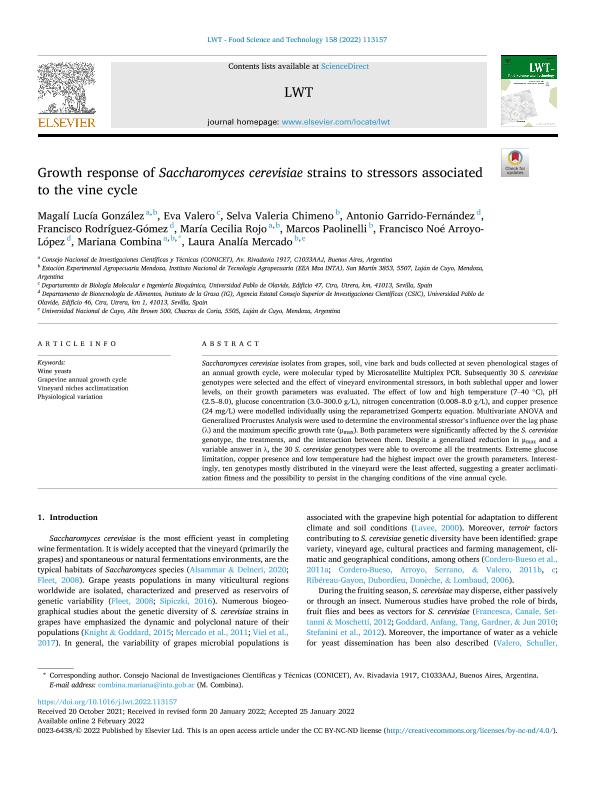Mostrar el registro sencillo del ítem
dc.contributor.author
González, Magalí Lucía Rosa

dc.contributor.author
Valero, Eva
dc.contributor.author
Chimeno, Selva Valeria

dc.contributor.author
Garrido Fernández, Antonio
dc.contributor.author
Rodríguez Gómez, Francisco
dc.contributor.author
Rojo, María Cecilia

dc.contributor.author
Paolinelli, Marcos

dc.contributor.author
Arroyo López, Francisco Noé
dc.contributor.author
Combina, Mariana

dc.contributor.author
Mercado, Laura Analia

dc.date.available
2023-07-07T18:47:07Z
dc.date.issued
2022-03
dc.identifier.citation
González, Magalí Lucía Rosa; Valero, Eva; Chimeno, Selva Valeria; Garrido Fernández, Antonio; Rodríguez Gómez, Francisco; et al.; Growth response of Saccharomyces cerevisiae strains to stressors associated to the vine cycle; Elsevier Science; LWT - Food Science and Technology; 158; 3-2022; 1-11
dc.identifier.issn
0023-6438
dc.identifier.uri
http://hdl.handle.net/11336/202768
dc.description.abstract
Saccharomyces cerevisiae isolates from grapes, soil, vine bark and buds collected at seven phenological stages of an annual growth cycle, were molecular typed by Microsatellite Multiplex PCR. Subsequently 30 S. cerevisiae genotypes were selected and the effect of vineyard environmental stressors, in both sublethal upper and lower levels, on their growth parameters was evaluated. The effect of low and high temperature (7–40 °C), pH (2.5–8.0), glucose concentration (3.0–300.0 g/L), nitrogen concentration (0.008–8.0 g/L), and copper presence (24 mg/L) were modelled individually using the reparametrized Gompertz equation. Multivariate ANOVA and Generalized Procrustes Analysis were used to determine the environmental stressor's influence over the lag phase (λ) and the maximum specific growth rate (μmax). Both parameters were significantly affected by the S. cerevisiae genotype, the treatments, and the interaction between them. Despite a generalized reduction in μmax and a variable answer in λ, the 30 S. cerevisiae genotypes were able to overcome all the treatments. Extreme glucose limitation, copper presence and low temperature had the highest impact over the growth parameters. Interestingly, ten genotypes mostly distributed in the vineyard were the least affected, suggesting a greater acclimatization fitness and the possibility to persist in the changing conditions of the vine annual cycle.
dc.format
application/pdf
dc.language.iso
eng
dc.publisher
Elsevier Science

dc.rights
info:eu-repo/semantics/openAccess
dc.rights.uri
https://creativecommons.org/licenses/by/2.5/ar/
dc.subject
GRAPEVINE ANNUAL GROWTH CYCLE
dc.subject
PHYSIOLOGICAL VARIATION
dc.subject
VINEYARD NICHES ACCLIMATIZATION
dc.subject
WINE YEASTS
dc.subject.classification
Alimentos y Bebidas

dc.subject.classification
Otras Ingenierías y Tecnologías

dc.subject.classification
INGENIERÍAS Y TECNOLOGÍAS

dc.title
Growth response of Saccharomyces cerevisiae strains to stressors associated to the vine cycle
dc.type
info:eu-repo/semantics/article
dc.type
info:ar-repo/semantics/artículo
dc.type
info:eu-repo/semantics/publishedVersion
dc.date.updated
2023-06-30T13:15:03Z
dc.journal.volume
158
dc.journal.pagination
1-11
dc.journal.pais
Países Bajos

dc.journal.ciudad
Amsterdam
dc.description.fil
Fil: González, Magalí Lucía Rosa. Consejo Nacional de Investigaciones Científicas y Técnicas. Centro Científico Tecnológico Conicet - Mendoza; Argentina. Instituto Nacional de Tecnología Agropecuaria. Centro Regional Mendoza-San Juan. Estación Experimental Agropecuaria Mendoza; Argentina
dc.description.fil
Fil: Valero, Eva. Consejo Superior de Investigaciones Científicas; España. Universidad Pablo de Olavide; España
dc.description.fil
Fil: Chimeno, Selva Valeria. Instituto Nacional de Tecnología Agropecuaria. Centro Regional Mendoza-San Juan. Estación Experimental Agropecuaria Mendoza; Argentina
dc.description.fil
Fil: Garrido Fernández, Antonio. Consejo Superior de Investigaciones Científicas; España. Universidad Pablo de Olavide; España
dc.description.fil
Fil: Rodríguez Gómez, Francisco. Consejo Superior de Investigaciones Científicas; España. Universidad Pablo de Olavide; España
dc.description.fil
Fil: Rojo, María Cecilia. Consejo Nacional de Investigaciones Científicas y Técnicas. Centro Científico Tecnológico Conicet - Mendoza; Argentina. Instituto Nacional de Tecnología Agropecuaria. Centro Regional Mendoza-San Juan. Estación Experimental Agropecuaria Mendoza; Argentina
dc.description.fil
Fil: Paolinelli, Marcos. Consejo Nacional de Investigaciones Científicas y Técnicas. Centro Científico Tecnológico Conicet - Mendoza; Argentina. Instituto Nacional de Tecnología Agropecuaria. Centro Regional Mendoza-San Juan. Estación Experimental Agropecuaria Mendoza; Argentina
dc.description.fil
Fil: Arroyo López, Francisco Noé. Consejo Superior de Investigaciones Científicas; España. Universidad Pablo de Olavide; España
dc.description.fil
Fil: Combina, Mariana. Consejo Nacional de Investigaciones Científicas y Técnicas. Centro Científico Tecnológico Conicet - Mendoza; Argentina. Instituto Nacional de Tecnología Agropecuaria. Centro Regional Mendoza-San Juan. Estación Experimental Agropecuaria Mendoza; Argentina
dc.description.fil
Fil: Mercado, Laura Analia. Consejo Nacional de Investigaciones Científicas y Técnicas. Centro Científico Tecnológico Conicet - Mendoza; Argentina. Instituto Nacional de Tecnología Agropecuaria. Centro Regional Mendoza-San Juan. Estación Experimental Agropecuaria Mendoza; Argentina. Universidad Nacional de Cuyo. Facultad de Ciencias Agrarias; Argentina
dc.journal.title
LWT - Food Science and Technology

dc.relation.alternativeid
info:eu-repo/semantics/altIdentifier/url/https://linkinghub.elsevier.com/retrieve/pii/S0023643822000925
dc.relation.alternativeid
info:eu-repo/semantics/altIdentifier/doi/http://dx.doi.org/10.1016/j.lwt.2022.113157
Archivos asociados
